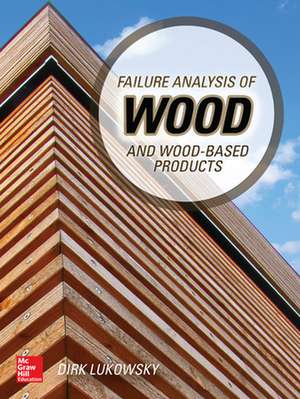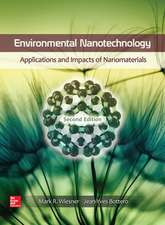Failure Analysis of Wood and Wood-Based Products
Autor Dirk Lukowskyen Limba Engleză Hardback – 16 mar 2015
Publisher's Note: Products purchased from Third Party sellers are not guaranteed by the publisher for quality, authenticity, or access to any online entitlements included with the product.
PRACTICAL, PROVEN METHODS FOR WOOD FAILURE ANALYSIS
Written by an expert in the field, this authoritative resource presents tested techniques for conducting in-depth, professional investigations of failures involving wood and wood-based products. The book offers a detailed look at the various causes of damage to wood, includingmaterial characteristics, design and conditions of use,and chemical influences.State-of-the-art forensic analysis methods such as tracking of relevant features, physical and chemical analysis, and microscopy are provided. This comprehensive guide shows you how to conduct efficient, costeffective,and reproducible wood failure investigations on site and inthe laboratory and deliver accurate findings and conclusions.
Failure Analysis of Wood and Wood-Based Products covers:
- Investigation strategy
- Methods of investigation
- Interpretation of features and distributions
- Examples of failures
Preț: 855.70 lei
Preț vechi: 1249.55 lei
-32% Nou
Puncte Express: 1284
Preț estimativ în valută:
163.78€ • 168.78$ • 138.27£
163.78€ • 168.78$ • 138.27£
Carte tipărită la comandă
Livrare economică 06-12 martie
Preluare comenzi: 021 569.72.76
Specificații
ISBN-13: 9780071839372
ISBN-10: 0071839372
Pagini: 240
Dimensiuni: 191 x 241 x 18 mm
Greutate: 0.75 kg
Editura: McGraw Hill Education
Colecția McGraw-Hill
Locul publicării:United States
ISBN-10: 0071839372
Pagini: 240
Dimensiuni: 191 x 241 x 18 mm
Greutate: 0.75 kg
Editura: McGraw Hill Education
Colecția McGraw-Hill
Locul publicării:United States
Cuprins
1 Preface 2 Principles of failure analysis 2.1 Avoiding mistakes 2.2 Sampling 2.3 Differential findings 2.3.1 Patterns 2.3.2 Time of appearance 2.3.3 Organizational hints 2.3.4 Comparison with common materials 3 Failure characteristics 3.1 Cracks 3.1.1 Cracks in MDF edges 3.1.2 Cracks in solid wood 3.2 Delamination 3.2.1 Adhesives 3.2.2 Coatings 3.3 Surface defects 3.3.1 Discoloration 3.3.2 Maceration 3.4 Deformation 4 Causes for failures 4.1 Solid wood4.1.1 Fiber deviations 4.1.2 Slip planes 4.1.3 Extractives 4.2 Wood composites 4.2.1 Delamination of coatings 4.2.2 Large particles/holes in the surface layer 4.2.3 Veneer cracks 4.3 Bonding 4.3.1 Glue thickness/pressure 4.3.2 Unpressed glue beads 4.3.3 Adhesive bleeding 4.4 Coating 4.4.1 Coating thickness 4.4.2 Microfoam 4.4.3 Surface preparation 4.4.4 Elasticity/ductility 4.5 Chemical influences 4.5.1 Coatings and adhesives 4.5.2 Reactions with iron 4.6 Geometrical aspects 4.6.1 Stress concentrations 4.6.2 Parallel veneers in plywood 4.6.3 Edge loss 4.7 Conditions of use 4.7.1 Moisture 4.7.2 UV radiation 4.7.3 Temperature 4.7.4 Mechanical stresses 5 Methods 5.1 Sampling 5.2 Documentation 5.2.1 Photography5.2.2 Scanning 5.2.3 Imprints 5.2.4 Frottage 5.2.5 Fluorescence 5.2.6 Accuracy of measurements 5.2.7 Estimation of distributions and amounts 5.3 Sanding from above 5.4 Patterns of features 5.4.1 Large scale patterns 31 drawings show possible patterns of defects and their interpretation. I have never seen anything similar in a publication. 5.4.2 Distribution in buildings 5.5 Chronology of patterns5.5.1 Discolorations and layer analysis5.5.2 Fungi/Insects 5.5.3 Honey bread effect 5.5.4 Thickness of materials 5.6 Reproduction of production- and use conditions 5.7 Wood moisture content 5.7.1 Electronic measurement5.7.2 Oven drying 5.7.3 Geometrical moisture estimation 5.7.4 Further hints for moisture conditions 5.8 Physical methods .5.8.1 Bonding tests 5.8.2 Mechanical coating testing 5.8.3 Water uptake/wetting/capillarity 5.8.4 Density 5.8.5 Thermal flow thermography5.8.6 Estimation of stresses 5.9 Microscopy 5.9.1 USB-Microscopes 5.9.2 Sample preparation 5.9.3 Lighting methods 5.9.4 Microscopic features in cross sections 5.9.5 Coating thickness and coating buildup 5.9.6 Analysis of starch grains 5.10 Chemical methods 5.10.1 Staining 5.10.2 Instrumental techniquesReferences Index









